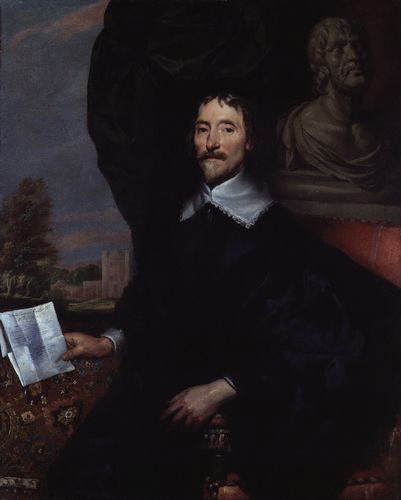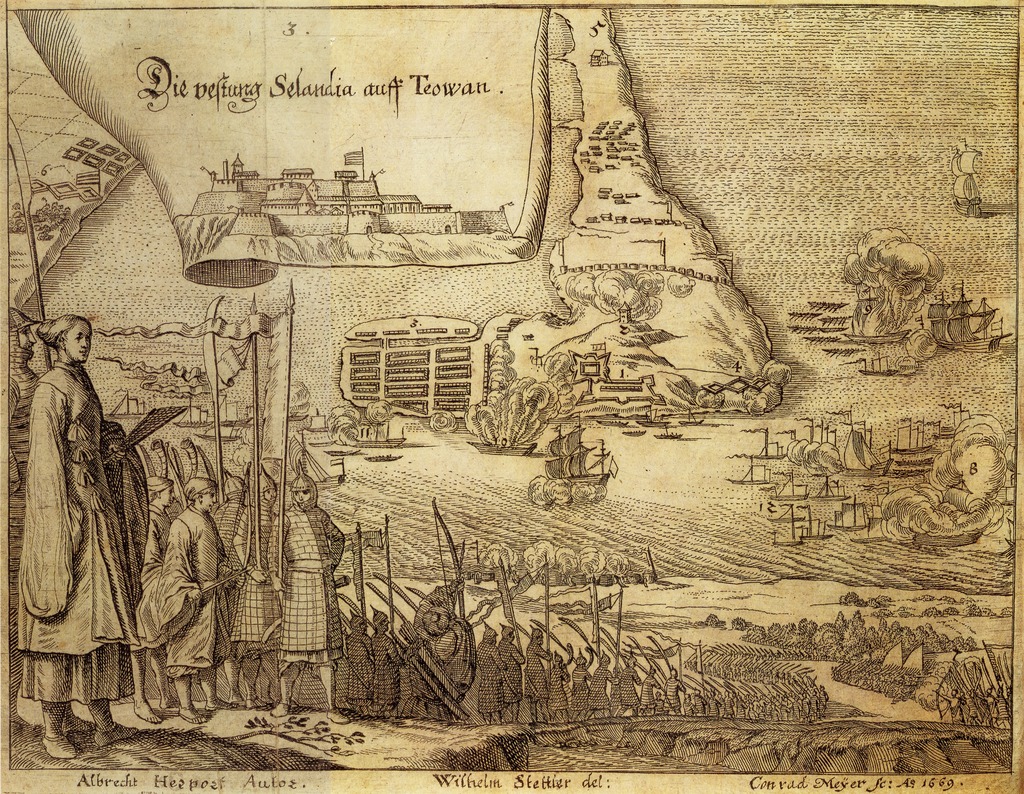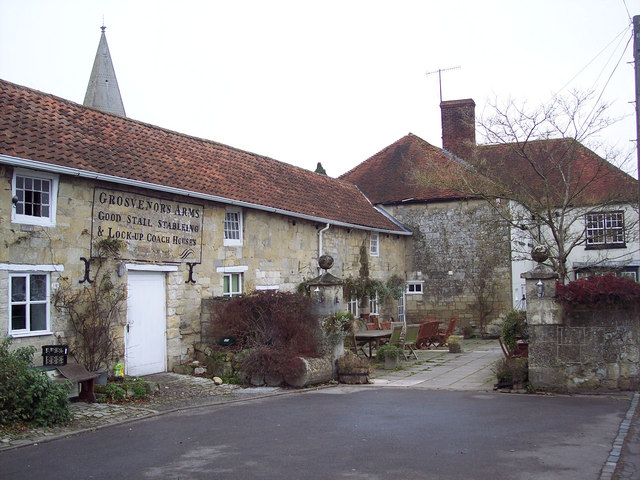|
Anne Denman
Anne Denman (1587 – 1661) was born in Olde Hall, Retford, Nottinghamshire. Through a second marriage with Thomas Aylesbury, she became the grandmother of Lady Anne Hyde, Duchess of York and great-grandmother of Queen Mary II and Queen Anne. Early life Anne was born in Olde Hall, West Retford in around 1587. She was the younger daughter of Francis Denman of Retford and Anne (Blount) Denman. Francis (born c. 1531, died 1599) was the rector of West Retford, Notts from 1578. He was the second son of Anne Hercy by her first husband, Nicholas Denman esq of East Retford, Notts. Francis had several sons who pre-deceased him and left two daughters as his heirs: Barbara (born c. 1583) who married Edward Darell (born c. 1582); and Anne. Anne's nephew, Dr John Darrell, was the youngest child of Barbara Denman and Edward Darell, and inherited substantial properties from both the Denman and Darell families. In 1665 just before his death he made a will dividing his estate between three ... [...More Info...] [...Related Items...] OR: [Wikipedia] [Google] [Baidu] |
Trinity Hospital Retford
Holy Trinity Hospital (known as Trinity Hospital) is a Grade II listed building in Retford, Nottinghamshire set in gardens off Hospital Road. It was established over 340 years ago, and has been a prominent Alms House since the 17th Century. The Old Hall and Founding of Trinity Hospital The site of Trinity Hospital was originally the site of the Old Hall of West Retford, the home of the Denmans and Darrells of Retford, who were related by marriage to the Hercy's of Grove, Nottinghamshire who lived at Grove Hall. According to Edwin Wilmshurst (1908), the Denmans were descended from Thomas Denman, a "knighted family" who held land at Tinslow (now Tinsley, near Sheffield) which he had inherited from William of Tynneslow. His descendant, Nicholas of Retforde married Ann, seventh daughter of Humphrey Hercy of Grove (and sister of Sir John Hercy), who inherited the Manor of West Retford. Nicholas and Anne Denman (née Hercy) had four sons: William (died 1568) without issue; Francis (d ... [...More Info...] [...Related Items...] OR: [Wikipedia] [Google] [Baidu] |
Henry Hyde, 2nd Earl Of Clarendon
Henry Hyde, 2nd Earl of Clarendon, PC (2 June 163831 October 1709) was an English aristocrat and politician. He held high office at the beginning of the reign of his brother-in-law, King James II. Early life He was the eldest son of Edward Hyde, 1st Earl of Clarendon, and his second wife, Frances Aylesbury. He was thus a brother of Anne Hyde, and maternal uncle to both Queen Mary II and Queen Anne. Both he and his brother Laurence Hyde were brought up partly at Antwerp and Breda, by their mother. Clarendon before 1660 made use of Henry as copyist, decipherer, and confidential secretary, in his correspondence with distant royalists. Under Charles II Soon after the return of his family to England, in 1660, Hyde married Theodosia Capell, daughter of Arthur Capell, 1st Baron Capell of Hadham, and Elizabeth Morrison, and sister of Mary Capell, Duchess of Beaufort. She died in 1661, and in 1670, he married secondly to Flower Backhouse, daughter of William Backhouse and Anne Ric ... [...More Info...] [...Related Items...] OR: [Wikipedia] [Google] [Baidu] |
Burials At Westminster Abbey
Burial, also known as interment or inhumation, is a method of final disposition whereby a dead body is placed into the ground, sometimes with objects. This is usually accomplished by excavating a pit or trench, placing the deceased and objects in it, and covering it over. A funeral is a ceremony that accompanies the final disposition. Evidence suggests that some archaic and early modern humans buried their dead. Burial is often seen as indicating respect for the dead. It has been used to prevent the odor of decay, to give family members closure and prevent them from witnessing the decomposition of their loved ones, and in many cultures it has been seen as a necessary step for the deceased to enter the afterlife or to give back to the cycle of life. Methods of burial may be heavily ritualized and can include natural burial (sometimes called "green burial"); embalming or mummification; and the use of containers for the dead, such as shrouds, coffins, grave liners, and buri ... [...More Info...] [...Related Items...] OR: [Wikipedia] [Google] [Baidu] |
1661 Deaths
Events January–March * January 6 – The Fifth Monarchists, led by Thomas Venner, unsuccessfully attempt to seize control of London; George Monck's regiment defeats them. * January 29 – The Rokeby baronets, a British nobility title is created. * January 30 – The body of Oliver Cromwell is exhumed and subjected to a posthumous execution in London, along with those of John Bradshaw and Henry Ireton. * February 5 – The Shunzhi Emperor of the Chinese Qing Dynasty dies, and is succeeded by his 7-year-old son the Kangxi Emperor. * February 7 – Shah Shuja, who was deprived of his claim to the throne of the Mughal Empire by his younger brother Aurangzeb, then fled to Burma, is killed by Indian troops in an attack on his residence at Arakan. * February 14 – George Monck’s regiment becomes ''The Lord General's Regiment of Foot Guards'' in England (which later becomes the Coldstream Guards). * March 9 – Following the death o ... [...More Info...] [...Related Items...] OR: [Wikipedia] [Google] [Baidu] |
1587 Births
Events January–March * January 7 – Sir Walter Raleigh appoints John White to be the Governor of the Roanoke Colony, to be established later in the year by English colonists on Roanoke Island off the coast of what is now the U.S. state of North Carolina.Andrew Lawler, '' The Secret Token: Myth, Obsession, and the Search for the Lost Colony of Roanoke'' (Doubleday, 2018) pp.90, 181-182 White and 121 other colonists depart from Portsmouth on three ships on May 8 and arrive at Croatoan Island on July 22. * January 14 – In Japan, Chancellor of the Realm Toyotomi Hideyoshi ends Portugal's control of the port of Nagasaki after six years. Omura Sumitada had leased the fishing village to Portuguese Jesuits on August 15, 1580. * February 5 – (1st waxing of Tabaung 948 ME) King Nanda of Burma appoints his eldest son and heir apparent, Minye Kyawswa II, as Viceroy of Ava, now part of upper Burma, with a capital at Inwa (located in what is now the Mandalay ... [...More Info...] [...Related Items...] OR: [Wikipedia] [Google] [Baidu] |
Godfrey Kneller
Sir Godfrey Kneller, 1st Baronet (born Gottfried Kniller; 8 August 1646 – 19 October 1723) was a German-born British painter. The leading Portrait painting, portraitist in England during the late Stuart period, Stuart and early Georgian eras, he served as court painter to successive Monarchy of the United Kingdom, English and British monarchs, including Charles II of England and George I of Great Britain. Kneller also painted scientists such as Isaac Newton, foreign monarchs such as Louis XIV of France and visitors to England such as Michael Shen Fu-Tsung. A pioneer of the kit-cat portrait, he was also commissioned by William III of England to paint eight "Hampton Court Beauties" to match a similar series of paintings of Charles II's "Windsor Beauties" that had been painted by Kneller's predecessor as court painter, Peter Lely. Early life Kneller was born Gottfried Kniller in the Free City of Lübeck, the son of Zacharias Kniller, a portrait painter.George Cokayne, Cokayne, ... [...More Info...] [...Related Items...] OR: [Wikipedia] [Google] [Baidu] |
Samuel Pepys
Samuel Pepys ( ; 23 February 1633 – 26 May 1703) was an English writer and Tories (British political party), Tory politician. He served as an official in the Navy Board and Member of Parliament (England), Member of Parliament, but is most remembered today for the diary he kept for almost a decade. Though he had no Maritime pilot, maritime experience, Pepys rose to be the Chief Secretary to the Admiralty under both Charles II of England, Charles II and James II of England, James II through patronage, diligence, and his talent for administration. His influence and reforms at the Admiralty (United Kingdom), English Admiralty were important in the early professionalisation of the Royal Navy. The detailed private diary that Pepys kept from 1660 until 1669 was first published in the 19th century and is one of the most important primary sources of the Stuart Restoration. It provides a combination of personal revelation and eyewitness accounts of great events, such as the Grea ... [...More Info...] [...Related Items...] OR: [Wikipedia] [Google] [Baidu] |
Hindon, Wiltshire
Hindon is a village and civil parish in Wiltshire, England, about west of Salisbury and south of Warminster. It is in the Cranborne Chase and West Wiltshire Downs Area of Outstanding Natural Beauty. Hindon was a market town but is now a village. History Hindon is a planned settlement, unlike most English villages which have evolved piecemeal over the millennia. If previous settlement in the area was present, no evidence within the village itself has yet been discovered. There are prehistoric field systems and Bronze Age round barrows on the downs nearby. According to the Estates' Account Rolls of the Bishop of Winchester, Bishop Peter des Roches of Winchester planned the borough as a centre for markets and fairs in 1218; at that time the land was part of East Knoyle parish. The main period of building was between 1218 and 1220 and even today, the medieval settlement pattern can be seen: the main tenements flanked either side of the High Street, with narrow burgage plot ... [...More Info...] [...Related Items...] OR: [Wikipedia] [Google] [Baidu] |
William Dobson Edward Hyde Earl Of Clarendon
William is a masculine given name of Germanic origin. It became popular in England after the Norman conquest in 1066,All Things William"Meaning & Origin of the Name"/ref> and remained so throughout the Middle Ages and into the modern era. It is sometimes abbreviated "Wm." Shortened familiar versions in English include Will or Wil, Wills, Willy, Willie, Bill, Billie, and Billy. A common Irish form is Liam. Scottish diminutives include Wull, Willie or Wullie (as in Oor Wullie). Female forms include Willa, Willemina, Wilma and Wilhelmina. Etymology William is related to the German given name ''Wilhelm''. Both ultimately descend from Proto-Germanic ''*Wiljahelmaz'', with a direct cognate also in the Old Norse name ''Vilhjalmr'' and a West Germanic borrowing into Medieval Latin ''Willelmus''. The Proto-Germanic name is a compound of *''wiljô'' "will, wish, desire" and *''helmaz'' "helm, helmet".Hanks, Hardcastle and Hodges, ''Oxford Dictionary of First Names'', Oxford Univer ... [...More Info...] [...Related Items...] OR: [Wikipedia] [Google] [Baidu] |
Thomas Keightley (official)
Thomas Keightley (1650–1719) was an English courtier and official in Ireland, who as brother-in-law to Henry Hyde, 2nd Earl of Clarendon played a role in the abdication of James II of England, James II. Life Baptised at Great Amwell, he was the son of William Keightley (born 1621) of Hertingfordbury, Hertfordshire, by his wife Anne, daughter of John Williams of London, (who had married in 1648). Thomas Keightley was appointed gentleman-usher to James, Duke of York, on 2 June 1672. Keightley appears to have temporarily adopted Catholicism, the religion of his master. Soon after his marriage in 1675 he sold his property at Hertingfordbury, and migrated to Ireland. On the appointment of his brother-in-law, Henry Hyde, 2nd Earl of Clarendon, to the lord-lieutenancy in the autumn of 1685, Keightley was admitted into intimate relations with the Irish government. He was appointed Vice-Treasurer of Ireland early in 1686, and in July following was sent to London by Clarendon, nominally ... [...More Info...] [...Related Items...] OR: [Wikipedia] [Google] [Baidu] |
HMS Gloucester (1660)
The English frigate ''Gloucester'' (spelt ''Glocester'' by contemporary sources) was a third rate, built for the Navy of the Commonwealth of England. The ship was ordered in December 1652 as part of the unprecedented expansion of the English navy during this period, during which 207 warships, mainly described as frigates, were built. She was named to commemorate the Parliamentary forces' successful defence of the English city of Gloucester during the 1643 Siege of Gloucester, siege by Royalist forces, rather than directly after the city itself. She was built by contract with shipwright Matthew Graves at Limehouse in East London, and launched in 1654. Background Following the end of the English Civil War in 1649, the new Commonwealth of England, Parliamentary regime was threatened by foreign powers and Cavalier, Royalist supporters exiled from Kingdom of England, England, who targeted maritime trade. To counteract these threats, the government began building up the strength o ... [...More Info...] [...Related Items...] OR: [Wikipedia] [Google] [Baidu] |








